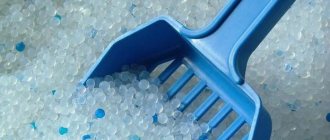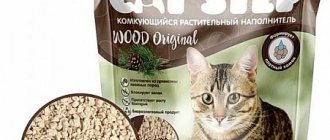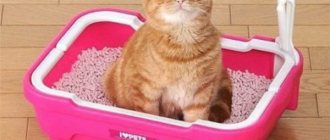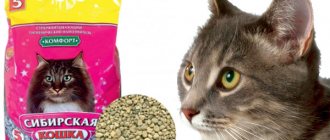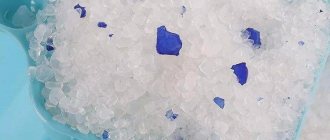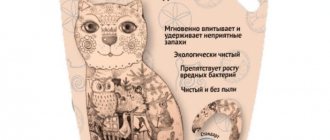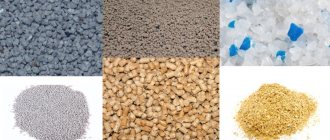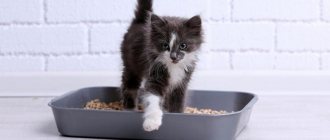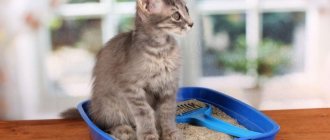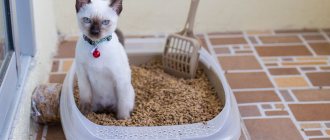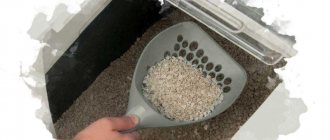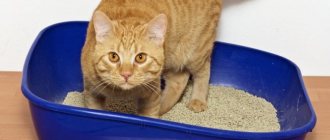The importance of choosing cat litter is undeniable. If the cat does not like what is in the tray, it may choose a completely different place to perform its natural needs.
The modern pet products market is diverse. Therefore, choosing a suitable substrate for a cat litter box is not so difficult: you just need to evaluate the pros and cons of each and make a decision. If the product you purchase does not suit your cat, you can always try other options.
comparison table
For the purpose of visual comparison of the presented funds, we use the comparison table below.
| Filler | Volume (l) | Compound | Antibacterial effect | Price, rub.) |
| Ever Clean | 10 | clay | Yes | from 1100 to 2527 |
| Barsik Standard | 4,5 | clay | Yes | from 78 to 326 |
| Zoonic | 5 | clay | Yes | from 120 to 672 |
| Pi-pi-bent | 10 | clay | Yes | from 256 to 931 |
| Fresh Step Extreme Clay | 12 | clay | Yes | from 904 to 2169 |
Which mixture should I choose for a kitten?
Since cats sometimes begin to eat all litter sprinkles, such mixtures are not recommended at all for pets under 4 months of age, especially silica gel or mineral ones. They can lead to the death of animals.
For babies over 4 months old, fillers with small balls are best. In this case, the tray should be deep and have a mesh so that the baby does not get his paws wet. You can put two different types into the toilet: wood on the bottom, mineral on top. If there is a mesh on top, then the kittens will not be able to reach the bedding to chew on it.
How to use it correctly?
There are a number of rules for using clumping litter that must be followed:
- First, wash and dry the tray thoroughly.
- Spread the filler in a thick layer of 3-5 cm. It is easy to remove lumps and animal waste products from such a layer. Exact recommendations are usually indicated on the packaging.
- After the animal relieves itself, the filler absorbs moisture and lumps form.
- You need to throw out the lumps every day with a special scoop.
- After cleaning, the filler should be added to the required level and leveled with a spatula.
- The tray should be completely changed approximately once every 1-2 weeks.
Remember, clumping fillers cannot be disposed of down the drain, otherwise the clay mass will harden and clog the pipe. Lumps should be placed in bags and thrown into the trash.
Types of mixtures
Cat litter is made in the form of balls, which can be small, medium and large. They all resemble the natural environment that a cat prefers. Granules are made from different materials that absorb liquid and even odors well. Some fillers need to be changed completely, while from others only used balls or lumps are selected.
© shutterstock
Bedding is divided into two main types - absorbent and clumping. They eliminate fluids in different ways. The types of cat litter also differ in the materials used for the production of granules :
- mineral based;
- corn;
- from sawdust of trees;
- clay-based;
- in the form of silica gel balls.
All fillers are collected differently. Clumping - into piles, absorbent - simply crumbles and does not need daily replacement.
What to look for when choosing
To choose a product that would satisfy both your pet and you, you should consider the type of filler.
- Clay. The advantages include its natural composition. The product is also suitable for cats of any age and is best accepted by them. Reminds me of regular soil. However, sometimes the product becomes dusty and sticks to the fur. It is worth considering that this filler cannot be disposed of in the sewer. Pipes may become clogged. Dust remains at the bottom of the package. Care must be taken.
- Silica gel. This type absorbs moisture best and copes well with unwanted odors. This filler should be changed once a week. The granules do not stick to the animal's paws and fur. There is no dust. But often the composition contains acids, so it is not advisable to buy such a product if you have a kitten.
- Woody. The most environmentally friendly type of filler. It can be flushed down the drain. The product has a natural aroma and is suitable for animals of any age. The disadvantages include frequent cleaning of the tray. In addition, the product sticks to the paws.
- Corn. This product can be flushed down the toilet and even used as fertilizer. The product absorbs moisture and odors well. However, there is a chance that the pet will scatter the granules outside the tray, because they are quite light in weight.
- Paper. This type is produced by processing paper raw materials. The advantages include rapid absorption of liquid and moisture. The granules will not stick to the paws. But such a product requires frequent replacement, and rustling noise is also heard when the cat is in the tray.
- Carbonic. Effectively absorbs all odors. Has antimicrobial effects. It absorbs moisture from the air, so it is not recommended to place a tray with this filler in bathrooms.
Types of the best cat litters
It is difficult to single out one type and call it the best - the choice is very individual. Today in stores you can give preference to one of three groups: organic, silica gel or mineral. If you are in doubt which litter is better and safer for kittens, definitely look towards organic ones.
Silica gel
This is the most expensive option, but it also consumes less than others. Fillers are absorbent superporous granular mixtures based on silica gel. Capable of absorbing a volume of liquid exceeding the volume of the filler by 30 times.
Pros:
- very economical, require complete replacement every two to three weeks;
- absorbs moisture better than all others and blocks odors;
- the surface always remains dry.
Minuses:
- quite expensive;
- they creak when animals walk on them;
- not recommended for kittens, as they cause poisoning if swallowed;
- difficult to dispose of, since when flushed down the drain they are guaranteed to cause a blockage.
Silica gel extremely rarely causes allergies, even in sensitive cats. Large granules are suitable for long-haired individuals, small ones - for short-haired and elderly cats.
Woody
Wood-shaving types are made by pressing sawdust mixtures remaining after woodworking, and are fairly dense small granules of a natural color. When wetted, the granules swell, lose their shape and crumble.
Pros:
- they are environmentally friendly, suitable for both adult animals and kittens;
- hypoallergenic;
- cats can chew woody substrate, and this is completely safe for their health;
- prices for this type of substrate are quite affordable;
- They are very easy to dispose of, even down to flushing them down the toilet.
Minuses:
- the main drawback is that it does not lock out specific aromas well;
- is not economical, since it has to be changed much more often than, for example, mineral ones (depending on the individual characteristics of the pet, it may be necessary to replace the substrate several times during the day);
- lightweight, so it is scattered from trays by animals.
When choosing wood chip filler in a store, it is worth considering that imported products have the same composition as domestic ones, but differ significantly in price.
Mineral
These are compositions based on clay, zeolite, opalcristobalite and other minerals. They are absorbent and clumping. Compared to organic ones (wood, paper, soy), they are somewhat more practical.
Pros:
- perfectly locks out unwanted odors;
- excellent moisture absorption;
- clumping ones are easy to dispose of, as they form a lump that can be easily removed from the tray with a scoop;
- environmentally friendly;
- heavy, so they don’t fly out of the tray;
- have affordable prices.
Minuses:
- stick to the animal’s paws and spread throughout the apartment;
- sharp stones can injure paw pads;
- some species generate dust;
- difficult to dispose of: you have to pour the granules into a bag and then throw them in the trash;
- Not recommended for kittens, as if they enter the gastrointestinal tract they can cause blockage.
Mineral litter is sometimes combined with wood litter if the cat litter box consists of two parts: a tray and a grid. Wood pellets are poured under the grate, and mineral granules are poured onto the grate. Only the used bottom layer (sawdust) is removed regularly, and the stones can be changed much less frequently. The advantage of this use is that it is a natural replacement for chemical silica gel, and it is even cheaper.
Corn, starch and soy
These types of cat litter belong to the organic group and are considered the most environmentally friendly and safe today. No flavorings or various impurities are added to their composition. Corn filler can only be absorbent, while the other two types, due to the starch in the composition, form lumps.
Pros:
- low consumption;
- ability to flush down the drain;
- efficiency;
- nice smell;
- affordable price;
- Possibility of use for animals suffering from allergic diseases.
Minuses:
- not always easy to find on sale (more often they are ordered online on foreign sites);
- gets the animal's paws dirty.
Starch, soy and corn fillers have an absolutely natural composition, so they are in demand in families with small children.
Paper
Also belongs to the group of products made from organic raw materials. Presented in the form of pressed paper granules. Many pet owners distinguish it from other species.
Pros:
- has a natural composition;
- perfectly neutralizes unpleasant odors;
- it contains antibacterial additives, which prevents the growth of bacteria;
- does not rustle when the animal uses the toilet;
- is safe for cats with allergies;
- it can be flushed down the drain.
Minuses:
- does not absorb liquid well enough;
- some complain of a specific smell.
Previously, people used regular paper for cat litter. Now technology is very developed, and the paper filler that we see on store shelves is not just overpriced paper. This is a high-quality raw material with powerful absorbent and antibacterial properties.
Carbonic
Thanks to the unique porous structure and special treatment with activated carbon, this type of substrate has a positive difference in properties. The coal type continues to rapidly gain the trust of customers.
Pros:
- safe for animals even if swallowed;
- has a high level of fluid absorption;
- quickly forms a lump upon contact with liquid;
- is environmentally friendly;
- actively fights bacteria.
Minuses:
- gets the animal's paws dirty;
- not available in all stores.
For some consumers, a significant advantage is that after use, coal granules can be used as fertilizer. They do not harm the soil; on the contrary, they saturate it with nutrients.
Which is the best clumping litter?
It is very important to choose a high-quality filler that will perform all the functions characteristic of a clumping hygiene product. Preference should be given to proven brands. Now there are many different manufacturers on the pet products market, but not all of them produce good quality products. Before purchasing, you should carefully study the packaging.
You need to pay attention to the following indicators:
Compound. Choose natural compositions made from wood or clay (bentonite, zeolite). The natural composition will not cause allergies in the animal or the owner.
Aroma. No matter how much you like the smell of sakura or the sea, refrain from purchasing such a hygiene product. The pet may refuse to go to the toilet, which has an unnatural smell. In addition, aroma additives can cause an allergic reaction.
Granule size. For long-haired cats, it is better to choose large granules. Small ones, like sand, are good for kittens. The size of the granules can be determined by feeling them through the bag. It’s good when the packaging is transparent or has a transparent insert. In this case, it is possible to evaluate not only the size of the granules, but also their condition.
Additional properties. A useful addition is the antibacterial effect. Some manufacturers add bactericidal substances to the composition, which prevent the development of pathogenic bacteria.
You can finally make sure that a particular filler is suitable only in practice.
Rating
For kittens, wood and absorbent mineral are best, for the owner of several cats - silica gel and wood. For those who want to provide environmentally friendly care for their pet, paper/grain and wood are suitable. For thrifty owners who want to purchase a quality product, wood or clumping mineral and clay filler would be an excellent choice.
The rating of the best fillers in this case will look like this:
- Wood is the simplest and most inexpensive.
- Clumping mineral and clay are the most natural.
- Silica gel is the most economical and high-quality.
- Paper/grain is the most environmentally friendly.
- Absorbent mineral is the most suitable for the owner of kittens or several cats.
Top 7 rating of clumping litters
We present the best clumping cat litters, which we selected based on user reviews.
Even Clean
Unique filler. Perfectly absorbs odor, masking it with a pleasant fresh aroma. Thanks to activated carbon, it can suppress unpleasant odors for a month. Has an antibacterial effect. Contains clay of different types. The most remarkable thing about this mixture is the instant formation of dense lumps. You will have to pay an expensive price of 1,400 rubles per 10 kg for such a product.
Cat's Best
Cat's best clumping filler is presented in wood form, such as fir sawdust. Its advantage is that it is biodegradable, which means it can be disposed of in the sewer. There are two lines in different packaging: with odor protection and for long-haired cats. The cost of the Original line is 1400 rubles for 8.60 kg/20 liters.
Fresh Step
Safe natural composition. Reliably eliminates odor. Contains activated carbon. It has both clumping and absorbent options in its line. The cost for 10 kg of mixture is 800 rubles.
Clean paws
The basis of the composition of the clean paw clumping filler is bentonite. Safe, good product. The line includes absorbent and clumping ones, and you can also purchase scented ones. Very attractive for its price. The average cost is 550 rubles per 10 kg.
Canada Letter
Canadian made product. Made from clay or corn dust. The mixture is highly hygroscopic. Granules can absorb a volume of liquid 3 times greater than their own. Contains natural flavors. Safe for animals. Cost for 10 kg 850 rubles.
Pi-Pi-Bent
Pi-Pi-Bent clumping filler is a universal line. Mixtures are presented specifically for long-haired cats. A composition without chemical additives is suitable for kittens. Most of the mixtures in the line are scented, but there is also an unscented product. Cost 500 rubles per 10 kg.
Katty clumping cat litter is sold under such brands as Pi-Pi-Bent, Kotyara, Kotoff, and CC Cat.
Zoonic
Zoonik clumping filler is based on bentonite clay. Due to its high hygroscopicity, it forms lumps well and absorbs odor. Users note an acceptable price, but unstable product quality. The cost is 170 rubles for 5 liters.
Possible difficulties
There are several reasons why a Sphynx may refuse to defecate in a litter tray. The first of them is that the cat simply does not like her toilet. It may not fit the size of the animal, making it difficult for him to concentrate in it. The main factor is considered to be a poorly washed pot. New smells and aromas can scare away a cat, or they may not like the litter. The Sphinx is a vindictive creature; if you raise your voice or raise your hand, it can become offended and specifically refuse to go to the litter box. This way he will mark his territory throughout the house and leave wet footprints in the most unpredictable places. If there are health problems, if there are problems with urination, the Sphynx may simply not have time to get to her own toilet and defecate wherever she has to. In this case, it is recommended to seek help from a veterinarian.
Which filler is clumping?
Clumping cat litter, as the name suggests, is capable of forming a lump. This process is based on the property of hygroscopicity. When wet, the granules swell and stick together, forming a lump. Lumps can be removed from the tray with a special spatula. It is very comfortable. In this case, replacing the entire mixture is not required.
The production of hygroscopic compositions requires materials with high absorption capacity. Products made from bentonite clay have proven themselves to be the best. Bentonite is absolutely safe for animals. During production, the material undergoes special processing to increase its hygroscopic properties.
Sometimes the mixture may contain aromatic additives. Their purpose is to mask the unpleasant smell of cat litter. But it is worth noting that not all cats will like litter with chemical additives.
Let's look at what a good clumping litter looks like in practice:
Stages of training
In order for the baby to quickly remember the latrine, he needs to be dropped off there after eating.
It is recommended to feed the Sphinx and carefully place it on the pot. One of the instincts of these animals is to bury their own feces. You need to wait a little until the pet gets used to it, sniffs the tray and then he can instinctively start digging in it. If the cat does not understand what to do, you need to take him by the front paw and show him the movement. After the first time, when it comes off in a small way, the smell of urine will remain on the filler, which will let the sphinx know that it needs to come back here again.
You cannot scold an animal if it fails to go potty on the first try. You need to bring the cat to the litter box over and over again and repeat the training procedure. If your bald pet continues to defecate in other places, you can take newspaper or paper, tear it into small pieces and soak it in urine. Next, take it to the cat's litter box and leave it on top of the litter.
You shouldn’t poke the sphinx’s nose into a puddle in the wrong place, hit it and scream. Otherwise, the animal may continue to “go about its business” throughout the house in retaliation.
If the owner’s attempts are not successful, then the animal should be shown to a doctor.
If you repeat the entire process without deviating from the goal, the cat will understand that it only needs to defecate in the tray. It doesn't take long to train a kitten, but there are exceptions. By the way, the Sphynx breed can be planted on a tray without filler. For many cats, this is the only option suitable. If your pet does not learn to go potty within 2-3 weeks, it is recommended to show him to a veterinarian to exclude the possibility of developing diseases of the genitourinary system.
